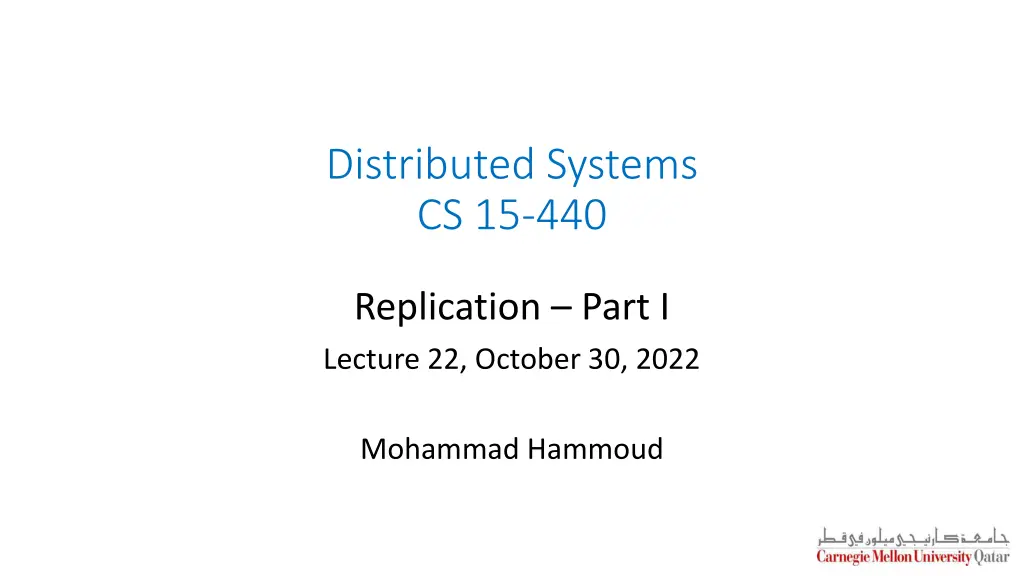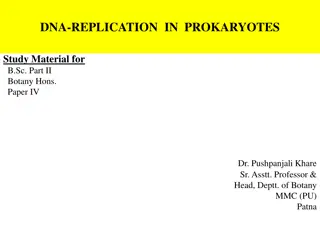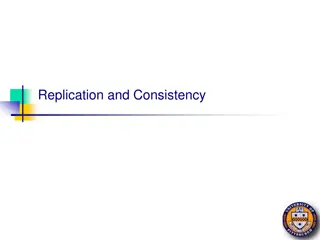
Understanding Distributed System Replication
Explore the significance of replication in distributed systems for improving performance, enhancing availability, scalability, and security against attacks. Learn about various replication examples and its role in consistency models and protocols.
Download Presentation

Please find below an Image/Link to download the presentation.
The content on the website is provided AS IS for your information and personal use only. It may not be sold, licensed, or shared on other websites without obtaining consent from the author. If you encounter any issues during the download, it is possible that the publisher has removed the file from their server.
You are allowed to download the files provided on this website for personal or commercial use, subject to the condition that they are used lawfully. All files are the property of their respective owners.
The content on the website is provided AS IS for your information and personal use only. It may not be sold, licensed, or shared on other websites without obtaining consent from the author.
E N D
Presentation Transcript
Distributed Systems CS 15-440 Replication Part I Lecture 22, October 30, 2022 Mohammad Hammoud
Today Last Session: Caching (or client-side replication) Part II Today s Session: Replication (or more precisely, server-side replication) Motivation and definitions Announcements: Quiz II is on Tuesday, Nov 1st PS5 will be posted today. It is due on November 6 by midnight
Overview Today s lecture Motivation Consistency Models Data-Centric Consistency Models Client-Centric Consistency Models Consistency Protocols Next two lectures
Overview Motivation Consistency Models Data-Centric Consistency Models Client-Centric Consistency Models Consistency Protocols
Why Replication? Replication is necessary for: 1. Improving performance A client can access nearby replicated copies and save latency 2. Increasing the availability of services Replication can mask failures such as server crashes and network disconnection 3. Enhancing the scalability of systems Requests to data can be distributed across many servers, which contain replicated copies of the data 4. Securing against malicious attacks Even if some replicas are malicious, security of data can be guaranteed by relying on replicated copies at non-compromised servers
1. Replication for Improving Performance Example: Replication at secondary servers in Content Delivery Network (CDNs) Main Server Secondary Servers
2. Replication for High-Availability Example: Google File-System replicates data blocks at computers across different racks, clusters, and data-centers If one computer or a rack or a cluster crashes, blocks can still be accessed from other sources
3. Replication for Enhancing Scalability Distributing data across replicated servers helps in saving the main server from becoming a performance bottleneck Example: Content Delivery Networks can decrease load at main (primary) servers Main Server Replicated Servers
4. Replication for Securing Against Malicious Attacks If a minority of servers in a system are malicious, the non-malicious servers can outvote the malicious ones This technique can also be used to provide fault-tolerance against non- malicious but faulty servers Example: In a peer-to-peer system, peers can coordinate to prevent delivering faulty data to the requester 1 2 5 Number of servers with correct data outvote the faulty servers 4 6 0 3 7 = Servers that do not have the requested data = Servers with correct data = Servers with faulty data n n n
Why Consistency? But (server-side) replication comes with a cost, which is the necessity for maintaining consistency (or more precisely consistent ordering of updates) Example: A Bank Database Event 2 = Add interest of 5% Event 1 = Add $1000 2 1 4 3 Bal=1000 Bal=2000 Bal=2100 Bal=1000 Bal=1050 Bal=2050 Replicated Database
Overview Motivation Consistency Models Data-Centric Consistency Models Client-Centric Consistency Models Consistency Protocols
Maintaining Consistency of Replicated Data DATA-STORE Replica 1 Replica 2 Replica 3 Replica n x=0 x=2 x=5 x=0 x=2 x=5 x=0 x=2 x=5 x=0 x=2 x=5 R(x)0 W(x)2 R(x)? R(x)5 Process 1 Process 2 R(x)? R(x)2 R(x)0 Process 3 W(x)5 Strict Consistency Data is always fresh After a write operation, the update is propagated to all the replicas A read operation will result in reading the most recent write If read-to-write ratio is low, this leads to large overheads =Read variable x; Result is b = Write variable x; Result is b =Process P1 =Timeline at P1 P1 R(x)b W(x)b
Maintaining Consistency of Replicated Data (Contd) DATA-STORE Replica 1 Replica 2 Replica 3 Replica n x=0 x=2 x=0 x=0 x=2 x=0 x=2 x=5 x=0 x=2 x=3 R(x)0 W(x)2 R(x)? R(x)5 Process 1 Process 2 R(x)? R(x)3 R(x)5 Process 3 W(x)5 Loose Consistency Data might be stale A read operation may result in reading a value that was written long back Replicas are generally out-of-sync The replicas may sync at coarse grained time, thus reducing the overhead =Read variable x; Result is b = Write variable x; Result is b =Process P1 =Timeline at P1 P1 R(x)b W(x)b
Trade-offs in Maintaining Consistency Maintaining consistency should balance between the strictness of consistency versus efficiency (or performance) Good-enough consistency depends on your application Loose Consistency Strict Consistency Easier to implement, and is efficient Generally hard to implement, and is inefficient
Consistency Model A consistency model is a contract between: The process that wants to use the data and the data-store A consistency model states the level (or degree) of consistency provided by the data-store to the processes while reading and writing data
Next Lecture Replication- Part II






















